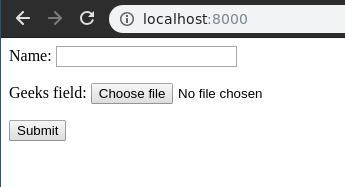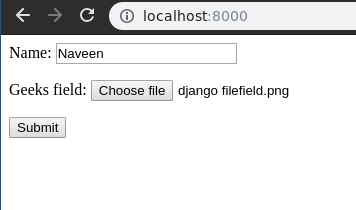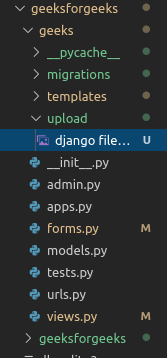FileField – Django 表单
Django Forms 中的 FileField 是用于上传文件的输入字段。此输入的默认小部件是 ClearableFileInput。它规范化为: 将文件内容和文件名包装到单个对象中的UploadedFile对象。它可以验证非空文件数据是否已绑定到表单。本文围绕如何使用 Django 表单上传文件以及如何将其保存到数据库。
笔记:
- 当 Django 处理文件上传时,文件数据最终放置在request.FILES中(有关请求对象的更多信息,请参阅请求和响应对象的文档)。
- 处理文件时,请确保 HTML 表单标签包含
enctype="multipart/form-data"属性。
句法
field_name = forms.FileField(**options)django表单文件字段说明
使用示例说明 FileField。考虑一个名为geeks的项目,它有一个名为geeksforgeeks的应用程序。
Refer to the following articles to check how to create a project and an app in Django.
- How to Create a Basic Project using MVT in Django?
- How to Create an App in Django ?
在geeks app的forms.py文件中输入以下代码。
from django import forms
class GeeksForm(forms.Form):
name = forms.CharField()
geeks_field = forms.FileField()
将极客应用添加到INSTALLED_APPS
# Application definition
INSTALLED_APPS = [
'django.contrib.admin',
'django.contrib.auth',
'django.contrib.contenttypes',
'django.contrib.sessions',
'django.contrib.messages',
'django.contrib.staticfiles',
'geeks',
]
现在要将这个表单渲染到一个视图中,我们需要一个视图和一个映射到该 URL 的 URL。我们先在geeks app的views.py中创建一个视图,
from django.shortcuts import render
from .forms import GeeksForm
# Create your views here.
def home_view(request):
context = {}
context['form'] = GeeksForm()
return render( request, "home.html", context)
在这里,我们从 forms.py 导入该特定表单并在视图中创建它的对象,以便可以在模板中呈现它。
现在,要启动一个 Django 表单,您需要创建 home.html,在其中可以根据需要设计内容。让我们在home.html中创建一个表单。
最后,在 urls.py 中映射到该视图的 URL
from django.urls import path
# importing views from views..py
from .views import home_view
urlpatterns = [
path('', home_view ),
]
让我们运行服务器并检查实际发生了什么,运行
Python manage.py runserver
因此,通过将“_”替换为“”来创建一个geeks_field 。它是从用户输入文件的字段。
如何使用 FileField 上传文件?
FileField 用于在数据库中输入文件。可以输入Email Id等。到目前为止,我们已经讨论了如何实现FileField,但是如何在视图中使用它来执行逻辑部分。为了执行一些逻辑,我们需要将输入到字段中的值放入Python字符串实例中。
FileField 与其他字段不同,需要妥善处理。如上所述,从 FileField 获取的数据将存储在request.FILES对象中。
在views.py中,
from django.shortcuts import render
from .forms import GeeksForm
def handle_uploaded_file(f):
with open('geeks / upload/'+f.name, 'wb+') as destination:
for chunk in f.chunks():
destination.write(chunk)
# Create your views here.
def home_view(request):
context = {}
if request.POST:
form = GeeksForm(request.POST, request.FILES)
if form.is_valid():
handle_uploaded_file(request.FILES["geeks_field"])
else:
form = GeeksForm()
context['form'] = form
return render(request, "home.html", context)
让我们解释一下这段代码的作用,这段代码将用户上传的文件保存在geeks目录的上传文件夹中。每当上传文件时,都会将其保存到 request.FILES 对象中,键为字段名称。所以我们创建了一个处理上传文件的函数,您可以选择自己对文件的用途,将其保存到数据库或对其进行操作或任何其他逻辑操作。让我们尝试将文件保存到上传文件夹。

它已成功加载,文件保存在极客应用程序的上传文件夹中。 
核心字段参数
核心字段参数是赋予每个字段以应用某些约束或将特定特征赋予特定字段的参数。例如,向 FileField 添加参数required = False将使用户可以将其留空。每个 Field 类构造函数至少采用这些参数。一些 Field 类采用额外的、特定于字段的参数,但应始终接受以下参数:
| Field Options | Description |
|---|---|
| required | By default, each Field class assumes the value is required, so to make it not required you need to set required=False |
| label | The label argument lets you specify the “human-friendly” label for this field. This is used when the Field is displayed in a Form. |
| label_suffix | The label_suffix argument lets you override the form’s label_suffix on a per-field basis. |
| widget | The widget argument lets you specify a Widget class to use when rendering this Field. See Widgets for more information. |
| help_text | The help_text argument lets you specify descriptive text for this Field. If you provide help_text, it will be displayed next to the Field when the Field is rendered by one of the convenience Form methods. |
| error_messages | The error_messages argument lets you override the default messages that the field will raise. Pass in a dictionary with keys matching the error messages you want to override. |
| validators | The validators argument lets you provide a list of validation functions for this field. |
| localize | The localize argument enables the localization of form data input, as well as the rendered output. |
| disabled. | The disabled boolean argument, when set to True, disables a form field using the disabled HTML attribute so that it won’t be editable by users. |
在评论中写代码?请使用 ide.geeksforgeeks.org,生成链接并在此处分享链接。